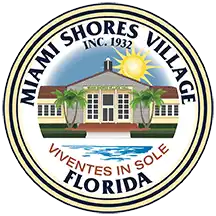The Miami Shores Story
January 2, 2012, Miami Shores Village attained its 80th anniversary. The thriving community of today was incorporated on January 2, 1932. However, its history precedes incorporation. Miami Shores Village, on the shores of Biscayne Bay, was first settled in the early 1870s. The Sturtevants, the Barnotts, the Potters, the Sears, the Woods, and the Hunts, were the names of some of the earliest homesteaders in the area. William Henry Hunt, together with William Henry Gleason, infamous carpetbaggers, were instrumental in founding the community, known then as Biscayne. A brief synopsis of this period follows:
In the early 1870s, William H. Gleason and William H. Hunt moved up the bay from Miami and founded the community of Biscayne. They brought with them the Miami Post Office, renaming it the Biscayne Post Office. Since the Dade County Court was wherever Gleason was, Biscayne was often the county seat and the meeting place of the county commission. Ephraim T. Sturtevant, Andrew Price, Edward Barnott, and Dr. Richard B. Potter were other settlers of Biscayne. One early visitor was Julia Tuttle, the daughter of Sturtevant and the “Mother of Miami.” By the 1880s, many of the early residents were gone and the post office was closed in 1888. Activity was renewed in Biscayne in 1892 with the building of the first county road, from Lantana to Lemon City, through Biscayne, and the post office was reopened. Later a railroad depot and a school were built. In the 1920s, Miami Shores was developed where the community of Biscayne once stood. (Historical Association of Southern Florida Marker – located on N.E. 96th Street and the bay).
By the early 1900s, the area encompassing today’s Miami Shores Village was occupied by a starch (coontie) mill, a tomato packing plant, a saw mill, a pineapple plantation, and a grapefruit grove. These were the various enterprises in which the early pioneers were engaged and with the coming of the railroad and its stop at the Biscayne Station, they were able to live off the land. Two of the most successful growers were Major Hugh Gordon and T. V. Moore. T.V. Moore owned the land in what is today’s commercial district, while the Gordon Tract bordered the bay. By 1922, Lee T. Cooper, who had amassed his wealth from a patent medicine by the name of Tanlac, purchased T.V. Moore’s land holdings. Cooper planned to develop the area and named it Bay View Estates. In 1924, the Shoreland Company purchased the Gordon Tract, Bay View Estates, and other scattered acreage in order to create Miami Shores, “America’s Mediterranean.”
Hugh M. Anderson, President of the Shoreland Company, and its Board of Directors were experienced real estate developers. They had previously completed the successful development of the Venetian Islands and they decided that their new project would be similar – residences of Italian inspired architecture within a landscape associated with water. The master development plan for Greater Miami Shores included 9,000 building sites, 5 2/3 miles of bay frontage, four miles of inland waterways, and 10 miles of main roadways. The plans also called for the construction of a causeway to Miami Beach, a golf course, a country club, a yacht club, a business district, apartment buildings, hotels, a school and churches, a railroad station, and beautifying features such as parks, plazas, and entryways.
Early in 1926, it was reported that approximately fifty homes had been completed, another fifty were under construction, and an additional one hundred were being planned. The commercial building program was in progress, sidewalks and roadways were being laid out and lighting and landscape work was well underway. Record-setting sales and resales of property were being recorded. Unfortunately, on September 18, 1926, all plans for the community came to a halt with the arrival of a devastating hurricane. In addition, other factors contributed to the Shoreland Company’s bankruptcy in 1927. In 1928, the New Miami Shores Corporation purchased the Shoreland Company’s holdings. This corporation was controlled by Bessemer Properties, part of the interests of the Phipps family of New York. Roy H. Hawkins, the General Manager of Bessemer Properties, proceeded with the plans for the community. He is credited as being the “principal founder” of Miami Shores Village. In 1931, under his leadership, a request to grant a charter creating Miami Shores Village was presented in the State Legislature. On January 2, 1932, the Village became official at a Council meeting. The charter named the following five members to the first council: Hugh H. Gordon, a banker whose father had owned the Gordon Tract; Frank O. Pruitt, who was in the insurance business; John M. Carlisle, President of the Eli Witt Cigar Company; W.F. Andes, a prominent dentist; and M.R. Harrison, a general contractor, who constructed much of Biscayne Boulevard. At this first meeting, Pruitt was elected Mayor, and other appointments were made including Village Manager, Miller Williams; Village Attorney, George E. Holt; and a single policeman, Ed Badger.
In the ensuing decades, growth was steady. A variety of architectural styles were introduced, yet the community emerged as the type of development the Shoreland Company had envisioned. The community retains many of its original characteristics – well situated and serviced by major highways, having tree-lined streets and wide roads, a downtown area, well-maintained homes provided with efficient services, and a variety of community activities. In its 82nd year, Miami Shores Village which has come to be known as “the Village Beautiful” remains one of Dade County’s most desirable suburbs.
